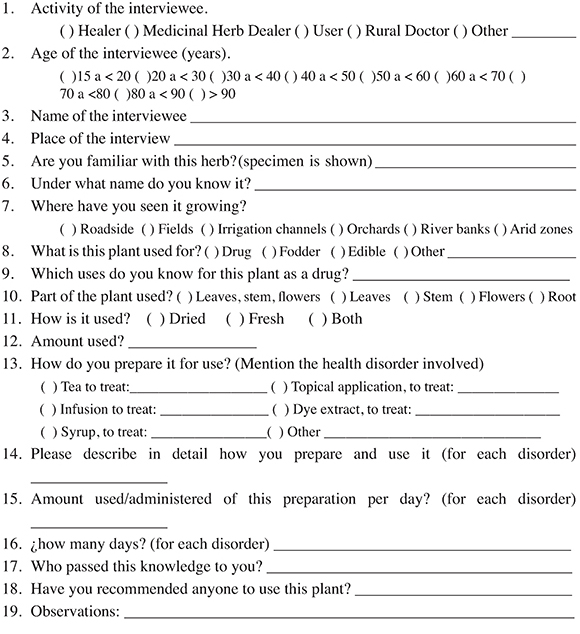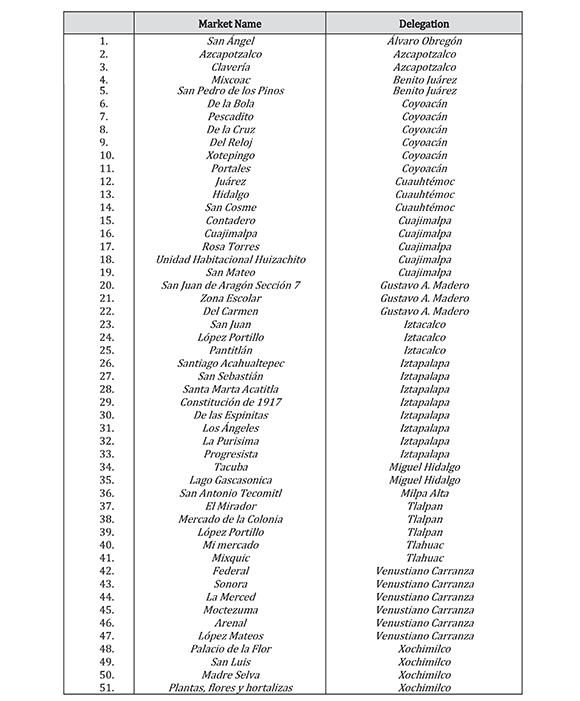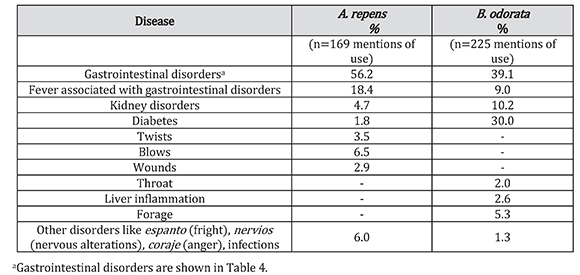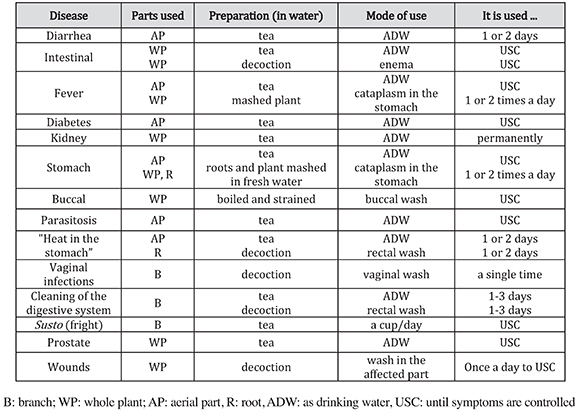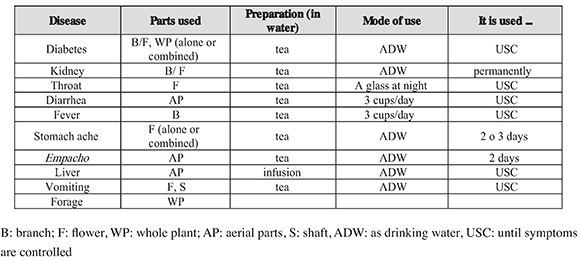Services on Demand
Journal
Article
Indicators
-
 Cited by SciELO
Cited by SciELO -
 Access statistics
Access statistics
Related links
-
 Cited by Google
Cited by Google -
 Similars in
SciELO
Similars in
SciELO -
 Similars in Google
Similars in Google
Share
Revista de Ciencias
Print version ISSN 0121-1935
rev. cienc. vol.19 no.2 Cali July/Dec. 2015
Alternanthera repens and Bidens odorata, Resilience Medicinal Plants in Mexico City
Adela Astudillo-Vázquez
Departamento de Biofísica, Escuela Nacional de Ciencias Biológicas, Instituto Politécnico Nacional, México D. F. - México
E-mail: adela_av@yahoo.com.mx
Hortencia Dávalos-Valle
Departamento de Biofísica, Escuela Nacional de Ciencias Biológicas, Instituto Politécnico Nacional, México D. F. - México
E-mail: davalosh4@yahoo.com.mx
Alfredo Patiño-Siciliano
Departamento de Botánica, Escuela Nacional de Ciencias Biológicas, Instituto Politécnico Nacional, México D. F. - México
apsiciliano@hotmail.com
Received: October 23, 2015
Accepted: October 27, 2015
Abstract
In Mexico, the use of medicinal plants to treat health disorders has been practiced since pre-Columbian times. Unfortunately, this knowledge has been lost over time, mainly in highly urbanized areas. We conduct an ethnobotanical survey about Alternanthera repens, Kuntze (Amaranthaceae) and Bidens odorata Cav. (Asteraceae) in Mexico City. A total of 500 people were interviewed, 250 of them were questioned about B. odorata and 250 in relation to A. repens, the questions included: common names, medicinal uses, part of the plant used, mode of preparation, route of administration and duration of treatment. This study revealed that both plant species are currently used in top diseases, in the study area, mostly to treat gastrointestinal disorders, specif cally diarrhea; A. repens is also recommended to treat fever and renal diseases, whereas B. odorata is used for treating diabetes, renal disorders and less frequently for fever and as forage. The results allow us to ensure that these plants are used today and are potentially important to continue with the determination of their pharmacological effects and other aspects.
Keywords: Alternanthera repens; Bidens odorata; Ethnobotanic; Mexican Traditional Medicine.
Introduction
The World Health Organization has acknowledged the importance of traditional medicine – with medicinal plants as the major resource – and has set forth strategies for research and use at a global level (OMS, 2002). Ethnobotanical studies are essential to identify the bioactive compounds of medicinal plants, which are currently used for the treatment of many diseases (Pieroni et al., 2004; Cameron et al., 2005; Bermúdez et al., (2005). Medicinal plants, within the Mexican traditional medicine, represent an important alternative to solve health problems in the country. The use of medicinal plants for the treatment of diseases is a common practice in Mexico as well as in other countries. These resources are usually regarded as part of a culture's "traditional" knowledge (Leonti et al., 2003; Heinrich et al., 2014).
Alternanthera repens Kuntze (Amaranthaceae) (Tianguis) and Bidens odorata Cav. (Asteraceae) (Acahualillo), both herbaceous plants are abundant in the country and they are included among the species that are used in the treatment of gastrointestinal disorders (Argueta, 1994).
A. repens is a medicinal plant that has been used since prehispanic times to treat a number of illnesses like typhus (matlazahuatl from Nahuatl language), and also as a diaphoretic, diuretic, astringent agent and for other purposes (Hernández, 1946). This species contains alkaloids, saponins, tannins and reducing sugars (Astudillo-Vázquez et al., 2008). In particular, it contains triterpene saponins (Sanoko et al., 1999). In vitro investigations, A. repens presented spasmolytic effect of methanol extract and fractions, on isolated rat ileum (Garín-Aguilar et al., 2014).
Bidens odorata contain alkaloids, favonoids, saponins, tannins and reducing sugars (Astudillo-Vázquez et al., 2008). B. odorata showed antidiarrheal activity on castor oil induced diarrhea on mice (Zavala-Mendoza et al., 2013).
Pharmacological tests showed that both aqueous and ethanol extracts from A. repens and B. odorata inhibited the advance of the gastrointestinal content using charcoal meal, in mice. Also, the lethal media doses in mice were estimated in order to examine the plants' safety founding that extracts can be regarded as slightly toxic; nevertheless none of these plants showed any toxic activity in the pharmacological proofs (Astudillo-Vázquez et al., 2008).
These investigations indicate a promissory pharmacological profle.
Therefore, it is important to know if A. repens and B. odorata are currently use by the population. Both plants are widely distributed around the world. Today, preserving the popular knowledge about the Mexican traditional medicine is crucial, especially in big cities like Mexico City. The purpose of this study was to carry out an ethnobotanical survey of A. repens and B. odorata in Mexico City.
2. Materials and Methods
2.1 Plant Material
Aerial parts of A. repens and B. odorata were collected from a number of urban environments in Mexico City, between July and September 2013 and 2014, including sidewalks, parking lots and streets.
2.2 Ethnobotanical Survey
Mexico City is the most populous entity and one of the most populated in the world, in 2010 it was inhabited by 8.851 million people, distributed in 16 delegations (Álvaro Obregón, Azcapotzalco, Benito Juárez, Coyoacán, Cuajimalpa, Cuauhtémoc, Gustavo A. Madero, Iztacalco, Iztapalapa, Magdalena Contreras, Miguel Hidalgo, Milpa Alta, Tláhuac, Tlalpan, Venustiano Carranza and Xochimilco) (INEGI, 2014).
In Mexico, markets have been fertile sources for ethnobotanical studies (Bye and Linares 1983; Taylor and Bogdan, 1994). In Mexico City markets, 250 persons were interviewed about their knowledge of A. repens (in 2013), and 250 about B. odorata (in 2014); a specimen of both plant species was always shown to them in order to avoid a potential misidentifcation. The information so gathered was processed to obtain the percentage of users, hierberos (specialists in medicinal plants, people who advise members of the community on how to use them), healers, merchants, etc., from the pool of persons interviewed. Also, diseases for which A. repens and B. odorata are currently used in the study area were recorded, as well as plant parts used, preparation, and mode of use for each species (Taylor and Bogdan, 1994; Souza-Brito, 1996; Bermúdez et al., 2005). The questionnaire was validated through its previous administration to 40 persons, adapting it as needed according to the results found. The resulting instrument is included in Table 1.
Table 1. Ethnobotanical Information Questionnaire
Results
To establish the size of the population sample to be interviewed in Mexico City, it was considered that only a few people possess the knowledge of interest, so those "privileged informants" (Harris, 1979; Taylor and Borgdan, 1994; López-Gutiérrez et al., 2014) were located and interviewed, most of them sell plants in markets. The markets of choice were representative of the diverse geographical areas of Mexico City. The most important among them is the Sonora market, Mexico's largest warehouse and supply center for medicinal plants (Bye and Linares, 1983) (Table 2).
Table 2. Markets Visited in Mexico City
It is signifcant that a plant species used in prehispanic times (Alternanthera repens, Tianguis) continues to be used and that a plant used as forage (Bidens odorata, Acahualillo) also has a medicinal use.
Main common names for the plants in the study area are:
Alternanthera repens: Tianguis, Tianguispepetla, Tianquizpepetla, Verdolaga del puerco and Tumina. Tianguispepetla and Tianquizpepetla are derived of tianquiztli (market) and pepetle (mat and grass) from the Nahuatl language, given to the plant because it was very abundant in Mexican markets in prehispanic times, exposed as green carpets (Hernández, 1946).
Bidens odorata: Acahualillo, Aceitilla and Mosote blanco.
The persons interviewed pointed out that both plants are used today in Mexico City; Tianguis is more frequently used, 69 % of persons in the sample use it (users), despite the fact that this plant was not sold in the markets surveyed.
The ethnobotanical survey showed that both plants are used for a variety of ailments, mainly in gastrointestinal disorders (Table 3), chiefy as an antidiarrheal agent (Table 4).
Table 3. Frequency Medicinal Uses for A. repens and B. odorata, According to the People Interviewed
aGastrointestinal disorders are shown in Table 4.
Table 4. Frecuency Gastrointestinal Uses for A. repens and B. odorata, According to the People Interviewed
Tianguis is also indicated to diminish fever caused by gastrointestinal diseases and kidney disorders.
Acahualillo is indicated as a treatment for diabetes and, in a lower degree, for kidneys disorders and to diminish fever (Table 3).
Statements about the plant's different uses, parts used, mode of preparation and application, doses and time of application recorded from the persons interviewed are shown in Tables 5 and 6. The most popular form of treatment, in both cases, is as a tea to treat gastrointestinal disorders, diabetes and kidney diseases.
Table 5. Ethnobotanic Information About Alternanthera repens, Obtained from People Interviewed.
Table 6. Ethnobotanic Information About Bidens odorata, Obtained from People Interviewed
Discussion and Conclusion
It is relevant to mention that Bidens odorata Cav. belongs to B. pilosa L. complex, however according to Melchert (1976) and Ballard (1975, 1986), it's important to recognize it like an independent specie. Both taxa are part of a complex of species that are similar, but genetically and ecologically different.
The two species belong to a group of closely related taxa, which systematic and taxonomy used to be confused for a long time. Ballard (1975, 1986) left it partially clear. This author found three species (with varieties each one): the diploid one (n = 12) Bidens odorata Cav., the tetraploid one B. alba (l.) DC (n = 24) and fnally, the hexaploid one
B. pilosa L. (n = 36). Different ploidy levels were associated with certain morphological features. Its classifcation was accepted by Melchert (1976), McVaugh (1984) and Rzedowski & Rzedowski (2001). Unfortunately, Ballard (1986) just treats the Bidens odorata varieties with codes and descriptions, whereas that the B. pilosa varieties are just mentioned superfcially (Vibrans, 1995).
Under the high morphological variability that present Bidens odorata Cav. population and often confused with B. pilosa (sensu Sherff in part) it should be noted that in this study we worked under the criteria mentioned by Rzedowski and Rzedowski (2001). So, Bidens odorata Cav. (B. pilosa L. sensu Sherff, in part) is one of the most common and widespread species in the Mexico Valley, which grows in felds, waysides, disturbed places, and secondary communities in general, and it is distributed from New Mexico and Nuevo León to Guatemala.
Ethnobotanical research has increased considerably in the last few years, and is presently considered a subject of great interest (Macía et al., 2005; Libman et al., 2006, López-Gutiérrez et al., 2014). Of particular interest are the plants used in Mexican traditional medicine (Leonti et al., 2003, Canales et al., 2005, Heinrich et al., 2014). Mexico is a country with a vast empiric ancestral knowledge on medicinal plants (Viesca, 2010), which has been transmitted verbally from generation to generation. Over time, this traditional knowledge is being lost so his rescue is imperative. This work attempts to rescue and validate the empiric popular knowledge of medicinal plants that Mexicans who live in highly urbanized cities still possess. In this research, the most valuable information was provided by people at least 50 years old.
It is surprising that both Tianguis and Acahualillo are grown in such inhospitable environments such as sidewalks, parking lots and streets; it was from these places that plants specimens were collected and where people who use the plants obtain them. Both Tianguis and Acahualillo are regarded as crop weeds and hence destroyed, but nevertheless they have managed to resist. All this shows the enormous natural resilience that these resources have.
The results of the ethnobotanical survey showed that both plant species are currently used as medicine, mainly to treat gastrointestinal disorders and especially for diarrhea, a disease with a high priority in Mexico and other countries (WHO, 2013); in Mexico, both gastrointestinal diseases such as diabetes mellitus are among the 20 leading causes of disease (SS, 2013); in 2012, diabetes caused 1.5 million deaths (WHO 2014); in the period of 1990-2013, mortality from diabetes and chronic kidney diseases, increased in Mexico and in the world (GBD, 2015); diarrheal diseases and diabetes mellitus are listed as causes of premature death worldwide (OMS, 2014). These facts pointed to the need to investigate the role of these medicinal plants in the mentioned diseases in experimental models.
Rescuing ethnobotanic information about plants used in the treatment of diarrheal disorders, diabetes and kidney diseases, in a high urbanized area is of great importance. In this work, the information obtained about the current use of A. repens and B. odorata set the basis for the experimental study of both species. Therefore, we aimed to fnd out whether there is a pharmacological support which validates the popular use of these plants.
Acknowledgements
These specimens were taxonomically identifed by Biol. Alfredo Patiño-Siciliano (Departamento de Botánica, Escuela Nacional de Ciencias Biológicas, Instituto Politécnico Nacional, México). Voucher specimens shown in the Herbarium ENCB, with numbers 1471 (A. repens) and 980 (B. odorata). We are thankful to QFI Gabriela Calderón, QFI Leyvert De Jesús and Mrs. Norma González for their technical assistance. A. Astudillo-Vázquez thanks for the COFAA-IPN grant. Sponsors: Secretaría de Investigación y Posgrado SIP-IPN (20151051).
References
Argueta, A. (1994). Atlas de las Plantas de la Medicina Tradicional Mexicana (I, p. 41; III, pp. 1334-1335). México D.F., México: Instituto Nacional Indigenista. [ Links ]
Astudillo-Vázquez, A., Dávalos, H., De Jesús, L., Herrera, G., y Navarrete, A. (2008). Investigation of Alternanthera repens and Bidens odorata on Gastrointestinal Disease. Fitoterapia, 79, 577-580. [ Links ]
Ballard, R. (1975). A biosystematic and chemotaxonomic study of the Bidens pilosa complex in North and Central America. Ph. D. Diss. University of Iowa, Iowa City, USA. [ Links ]
Ballard, R. (1986). Bidens pilosa complex (Asteraceae) in North and Central America. American Journal of Botany, 73, 1452-1465. [ Links ]
Bermúdez, A., Oliveira-Miranda, M. A., y Velázquez, D. (2005). La Investigación Etnobotánica sobre Plantas Medicinales: Una Revisión de sus Objetivos y Enfoques Actuales. Interciencia, 30, 453-459. [ Links ]
Bye, R. A., & Linares, E. (1983). The Role of Plants Found in the Mexican Markets and Their Importance in Ethnobotanical Studies. Journal of Ethnobiology, 3, 1-13. [ Links ]
Cameron, S. I., Smith, R. F., y Kierstead, K. E. (2005). Linking Medicinal / Nutraceutical Products Research with Commercialization. Pharmaceutical Biology, 43, 425-433. [ Links ]
Canales, M., Hernández, T., Caballero, J., Romo De Vivar, A., Ávila, G., Durán, A., & Lira, R. (2005). Informant Consensus Factor and Antibacterial Activity of the Medicinal Plants Used by the People of San Rafael Coxcatlán, Puebla, México. Journal of Ethnopharmacology, 97, 429-439. [ Links ]
Garín-Aguilar, M. E., Benavides-Catalán, D., Segura, D., Ramírez-Sotelo, G., Piña, A. B., & Valencia-Del Toro, G. (2014). Spasmolytic Effect of Alternanthera repens on Isolated Rat Ileum. Pharmaceutical Biology, 52, 479-485. [ Links ]
GBD Global Burden of Disease. (2015). Global, Regional, and National Age-Sex Specifc All-Cause and Cause-Specifc Mortality for 240 Causes of Death, 19902013: A Systematic Analysis for the Global Burden of Disease Study 2013. Lancet 2015, n. 385 (pp. 117-71). [ Links ]
Harris, M. (1979). El Desarrollo de la Teoría Antropológica. Historia de las Teorías de la Cultura. México D.F., México: Siglo XXI editores, 362-363. [ Links ]
Heinrich, M., Frei Haller, B., & Leonti, M. (2014). A Perspective on Natural Products Research and Ethnopharmacology in Mexico: The Eagle and the Serpent on the Prickly Pear Cactus. Journal of Natural Products, 77, 678-89. [doi: 10.1021/np4009927] [ Links ].
Hernández, F. (1946). Historia de las Plantas de Nueva España. México D.F., México: Imprenta Universitaria. [ Links ]
Holm, L. G., Plucknett, D. L., Pancho, J. V., & J. P. Herberger. (1977). The world's worst weeds. Distribution and ecology. Honolulu, USA: University Press. [ Links ]
INEGI. (2014). Instituto Nacional de Estadística y Geografía. Recovered 17/08/2015 http://www3.inegi.org.mx/ [ Links ]
Leonti, M., Sticher, O., & Heinrich, M. (2003). Antiquity of Medicinal Plant Usage in Two Macro-Mayan Ethnic Groups. Journal of Ethnopharmacology, 88,119-24. [ Links ]
Libman, A., Bouamanivong, S., Southavong, B., Sydara, K., & Soejarto, D. D. (2006). Medicinal Plants: An Important Asset to Health Care in a Region of Central Laos. Journal of Ethnopharmacology, 106, 303-311. [ Links ]
López-Gutiérrez, B. N., Pérez-Escandón, B. E., y Villavicencio, M. A. (2014). Aprovechamiento Sostenible y Conservación de Plantas Medicinales en Cantarranas, Huehuetla, Hidalgo, México, Como un Medio Para Mejorar la Calidad de Vida en la Comunidad. Botanical Sciences, 92, 389-404. [ Links ]
Macía, M. J., García, E., & Vidaurre, P. J. (2005). An Ethnobotanical Survey of Medicinal Plants Commercialized in the Markets of La Paz and El Alto, Bolivia. Journal of Ethnopharmacology, 97, 337-350. [ Links ]
McVaugh, R. (1984). Flora Novo-Galiciana. A descriptive account of the vascular plants of Western Mexico. Compositae, v. 12. Ann Arbor, USA: University of Michigan Press. [ Links ]
Melchert, T. E. (1976). Bidens, in Flora of Guatemala. Fieldiana-Botany, 24, 193-214. [ Links ]
OMS. Organización Mundial de la Salud. (2002). Estrategia de la OMS sobre Medicina Tradicional 2002-2005. Ginebra, Suiza: OMS. [ Links ]
OMS. Organización Mundial de la Salud. (2014). Estadísticas Sanitarias Mundiales 2014. Una Mina de Información sobre Salud Pública Mundial. Geneva, Switzerland: WHO Document Production Services. WHO/HWIS/HSI/14.1, 12. [ Links ]
Pieroni, A., Quave, C. L., & Santoro, R. F. (2004). Folk Pharmaceutical Knowledge in the Territory of the Dolomiti Lucane, in Land Southern Italy. Journal of Ethnopharmacology, 95, 373-384. [ Links ]
Rzedowski, J., y Calderón de Rzedowski, G. C. (2001). Flora fanerogámica del Valle de México Segunda edición. México D.F., México: Instituto de Ecología, A.C. y Comisión Nacional para el Conocimiento y Uso de la Biodiversidad. [ Links ]
Sanoko, R., Speranza, G., Pizza, C., & De Tommasi, N. (1999). Triterpene Saponins from Alternanthera repens. Phytochemistry, 51, 1043-1047. [ Links ]
Souza-Brito, A. R. M. (1996). How to Study the Pharmacology of Medicinal Plants in Underdevelop Countries. Journal of Ethnopharmacology, 54, 131-138. [ Links ]
SS. Secretaría de Salud. Dirección General de Epidemiología. (2013). Información Epidemiológica de Morbilidad. Anuario Ejecutivo 2012. México D.F., México: Secretaría de Salud. Dirección General de Epidemiología (p. 192). [ Links ]
Taylor, S. J., y Bogdan, R. (1994). Introducción a los Métodos Cualitativos de Investigación. Barcelona, España: Editorial Ediciones Paidós. [ Links ]
Vibrans, H. (1995). Bidens pilosa l. y Bidens odorata Cav. (Asteraceae: Heliantheae) en la vegetación urbana de la Ciudad de México. Acta Botánica Mexicana, 32, 85-89. [ Links ]
Viesca, T. C. (2010). Medicina del México Antiguo. Recuperado 17/08/2015 www.medicinaysalud.unam.mx/temas/2010 [ Links ]
WHO World Health Organization. (2014). Global Status Report on noncommunicable diseases 2014. Geneva, Switzerland: Publications of the World Health Organization. [ Links ]
WHO. World Health Organization (2013). Diarrhoeal disease. Fact sheet N° 330. Recovered 17/08/2015 http://www.who.int/mediacentre/factsheets/fs330/en/ [ Links ]
Zavala-Mendoza, D., Alarcón-Aguilar, F. J., Pérez-Gutiérrez, S., Escobar-Villanueva, M. C. & Zavala-Sánchez, M. A. (2013). Composition and Antidiarrheal Activity of Bidens odorata Cav. Evidence-Based Complementary and Alternative Medicine 2013: 170290 [DOI: 10.1155/2013/170290] [ Links ].

Revista de Ciencias por Universidad del Valle se encuentra bajo una licencia Creative Commons Reconocimiento 4.0.













